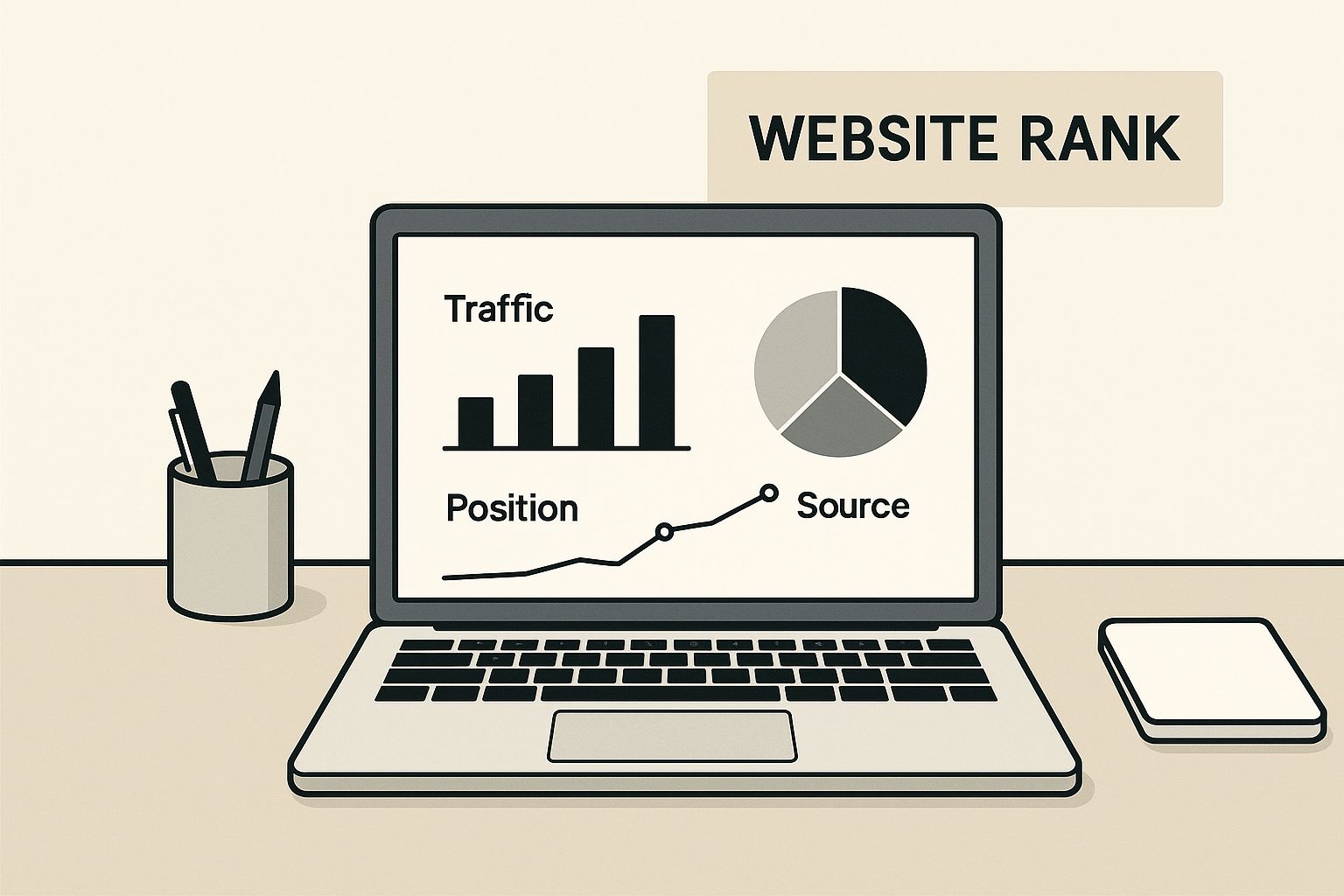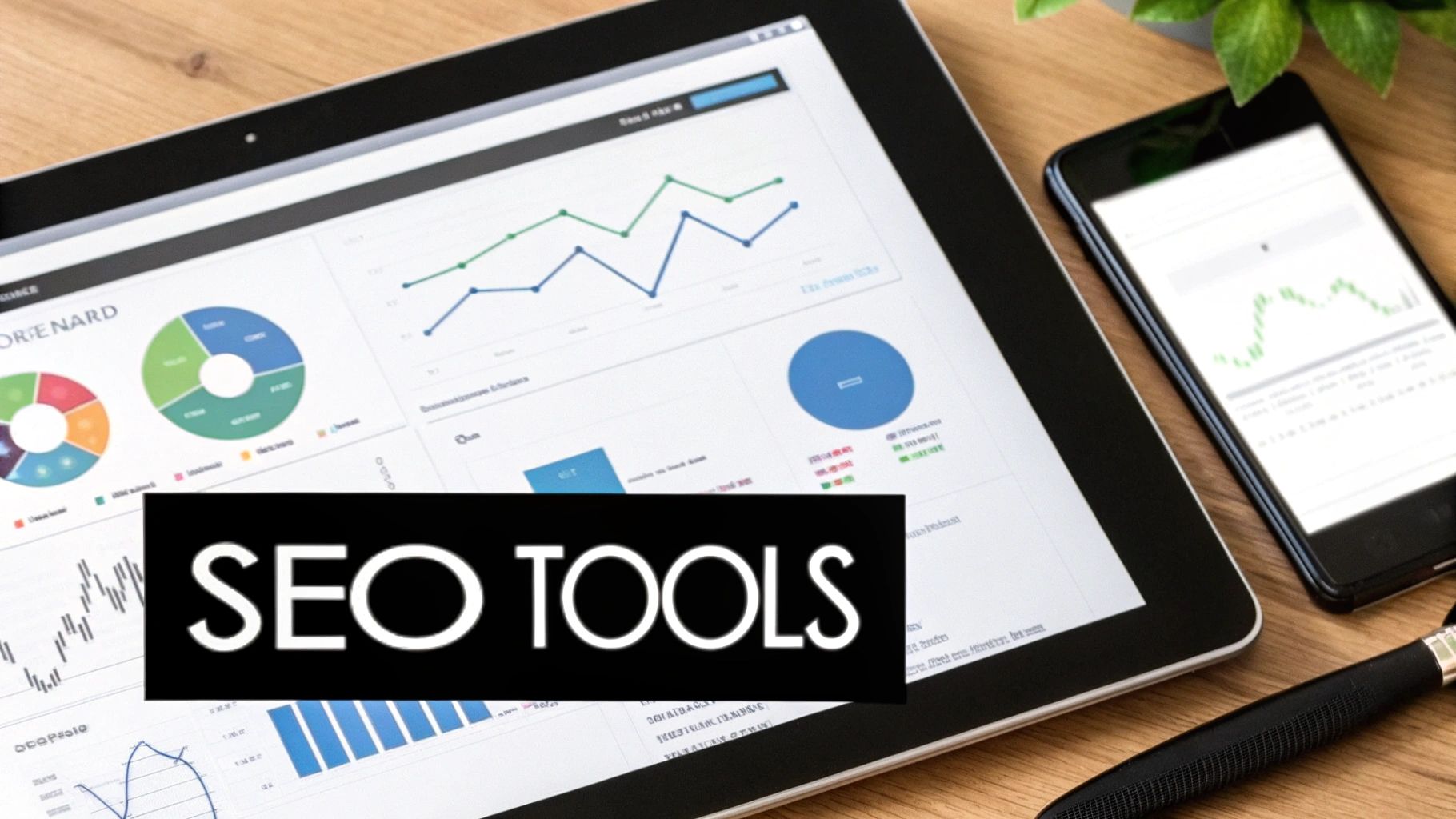The Truth About Website Rankings (And Why They're Trickier Than You Think)
Let me tell you something about website rankings: they're not as straightforward as you might think. After talking with countless SEO experts and poring over tons of ranking data, I've realized something important: Google’s sheer dominance creates amazing opportunities, but it also presents some real challenges. Getting your head around this is the first step to understanding how to find your website's rank.
Imagine Google as a massive library. It's packed with almost every book (website) imaginable, and it's constantly shuffling the books around on its shelves based on what it thinks people want to read. This means your "spot" on the shelf (your ranking) can fluctuate daily, even if you haven't changed a single thing on your website. Trust me, I know how frustrating that can be.
This is why it's so important to understand search engine dominance, particularly Google's. They control a massive portion of web traffic. As of July 2023, Google held about 81.95% of the desktop search market, leaving competitors like Bing trailing behind at 10.51%. Think about this: Google Search, Google Images, and Google Maps combined account for nearly 93% of global web traffic. This just shows how crucial Google is when you're trying to boost your website’s visibility. Want to see more website stats? Check out this article: Discover more insights.
Another key point: the type of search someone performs drastically impacts your ranking. Someone searching for "best pizza near me" will see totally different results than someone searching for "how to make pizza dough". Your website might rank high for one search and be completely invisible for the other. This is where grasping search intent is essential. It's not enough to just track your ranking for a keyword; you need to understand why people are searching and whether your content truly answers their question. This deeper understanding is what separates temporary rankings from real, traffic-driving success.
Smart Ways to Track Rankings Without Spending a Fortune
Let's be honest, premium SEO tools can drain your budget fast. But the good news is, you absolutely don't need them to keep tabs on your website's ranking. I've played around with a bunch of free methods, and I'm excited to share the ones that actually deliver.

The infographic above shows a simple workstation with a laptop open to a website analytics dashboard. See that "Website Rank" indicator? It's a visual reminder that valuable ranking insights are within reach, even with basic tools. You don't need a fancy setup or expensive software.
For instance, Google Search Console is a goldmine. Most people barely scratch the surface, but it’s packed with data. Think of it as your detective's toolkit for uncovering insights that even paid tools miss. And a solid blog post SEO checklist is your foundation—making sure your website is set up for ranking success from the get-go.
Manual Tracking That Doesn't Waste Your Time
Manual tracking can be useful, but I've seen people spin their wheels with ineffective methods. I'll show you the ones that save you time and give you reliable data. One major pitfall is relying on personalized search results. Your search history skews what Google shows you, so you won't see true rankings. Incognito mode is your best friend here.
Beyond incognito searches, free tools often have hidden features that most people overlook. It’s like finding secret passages in a video game – they unlock powerful shortcuts. We'll explore those features and how to use them to your advantage.
Keeping an Eye on the Competition (and Your Local SEO)
Want to track competitor rankings and local search positions without breaking the bank? It’s totally doable. We'll dive into how to monitor your competition and your local SEO performance without spending a dime. Curious about daily rank tracking? This article on daily rank tracking info might be helpful.
Here's a quick overview of some free tools I've found helpful:
Free Website Rank Checking Tools Comparison A detailed comparison of the most popular free tools for checking website rankings, including their features, limitations, and best use cases.
| Tool Name | Key Features | Limitations | Best For |
|---|---|---|---|
| Google Search Console | Provides average position data, click-through rates, and impression data directly from Google. | Doesn't provide exact rankings, data can be a few days old. | Understanding overall search visibility and identifying areas for improvement. |
| SERPRobot | Free limited checks for a specific keyword. | Limited number of free checks. | Quickly checking rankings for a few keywords. |
| What's My SERP | Simple interface for checking rankings in different locations. | Can be less accurate for highly competitive keywords. | Checking rankings for local SEO. |
These free tools, combined with the right strategies, give you the power to understand your website rank effectively, no matter your budget.
Premium Tools That Actually Justify Their Price Tags
So, you're thinking about leveling up your rank tracking game and investing in some serious tools? I get it. The options can be overwhelming, and every platform promises to be the best. I've spent years testing these tools for all kinds of businesses, and I’m happy to share what I've learned. Let’s cut through the marketing fluff and focus on features that actually make a difference in your ranking strategy and how to truly understand where your website stands.
There are clever ways to track your rankings without breaking the bank. For example, you could check out these YouTube video rank tracking strategies. But if you're ready for the pros, platforms like SEMrush, Ahrefs, and Moz are where it's at. Even these giants have their quirks, though. Standard reviews rarely tell the whole story, so I’ll give you my honest take on their limitations based on my own experience.
Navigating the Premium Tool Landscape
Let’s start with Ahrefs. It’s fantastic for competitive analysis, and its rank tracking is solid. Here's a glimpse of their interface:

This dashboard is clean and packed with data. You can easily see how it gives you insights into keywords, backlinks, and overall website performance—all essential for understanding your rankings.
Then there's SEMrush, a seriously comprehensive suite. It covers everything from keyword research to site auditing. This wide range of features does mean a steeper learning curve. Moz, on the other hand, focuses on building a strong SEO community alongside its powerful tools. This supportive environment is a huge plus, especially if you're new to professional SEO.
Calculating the True Cost (and Maximizing Your ROI)
Of course, pricing is a major consideration. We'll get into the real cost of these tools. It’s not just the monthly subscription—it’s the time you spend learning the platform and actually using it effectively. I'll share my tips for getting the most out of your investment and avoiding features you won’t need. The right tool is different for everyone. It all depends on your business, your goals, and your workflow.
To help you compare, I’ve put together a table outlining the key features and pricing of some popular premium rank tracking tools.
Here's a quick look at what each tool brings to the table:
Premium Rank Tracking Tools Feature Matrix Comprehensive comparison of premium tools showing their ranking tracking capabilities, pricing, and unique features
| Tool | Keywords Tracked | Monthly Price | Unique Features | Best Use Case |
|---|---|---|---|---|
| SEMrush | Varies by plan, starting at 500 | Starting at $119.95/month | Comprehensive SEO suite, including competitor analysis, site audit, and more | Businesses needing a complete SEO solution |
| Ahrefs | Varies by plan, starting at 750 | Starting at $99/month | Strong competitive analysis features, backlink analysis, and rank tracking | Businesses focused on competitor analysis and link building |
| Moz | Varies by plan, starting at 300 | Starting at $99/month | Focus on SEO community, keyword research, and rank tracking | Businesses prioritizing community support and keyword research |
This table offers a snapshot of the costs and benefits. Keep in mind that pricing and features can change, so it's always a good idea to check the tools' websites for the most up-to-date info. What works for one business might not work for another, so think about your specific needs before committing.
Facing the Reality of Modern Search Competition
Let's be honest, ranking a website is a real struggle these days. The internet is a crowded place. I've seen countless people spin their wheels trying to boost their site's visibility, often relying on outdated SEO tactics that just don't work anymore. This section will help you understand the challenges and prepare for the fight.
With over 1.13 billion websites vying for attention (check out these stats), the competition is fierce. Getting your site noticed is a serious undertaking. Sure, SEO can drive a ton more traffic than social media – some say over 1,000% more – but it's not a quick fix. You need a smart strategy, a lot of persistence, and a realistic view of the landscape.
Why Traditional Ranking Advice Falls Short
You’ve probably seen tons of articles saying, "Just create great content!" While quality content is crucial, it's only part of the equation. You're not just competing against other businesses your size; you're up against huge corporations with dedicated SEO teams and massive budgets. Trying to outrank them for common keywords is a losing battle.
This is where a lot of people get tripped up. They target those high-volume, generic keywords, thinking that's the key to success. But what they don't realize is that they're fighting a battle they're almost guaranteed to lose. This can be incredibly frustrating and leads to a lot of wasted time and effort.
Identifying Winnable Battles and Overlooked Opportunities
Instead of banging your head against the wall trying to rank for the most popular keywords, focus on finding "winnable battles." This often means targeting long-tail keywords. These are more specific phrases with lower search volume but higher user intent.
For example, if you're selling running shoes, trying to rank for "shoes" is incredibly difficult. Instead, you might target something like "best running shoes for flat feet women." See the difference? You’re attracting a more targeted audience and have a much better chance of actually ranking.
Another tactic is to look for overlooked opportunities. Larger competitors might be missing niche topics or keywords that are relevant to your business. By focusing on these untapped areas, you can carve out your own space online. Remember, small wins add up over time.
Decoding Your Ranking Data Like a Pro

So, you’ve pulled together all your ranking data. Great! Now, what do you do with it? Just staring at the raw numbers isn’t going to get you anywhere. The real value comes from understanding what that data means. It's where the rubber meets the road, and honestly, it’s where I see a lot of folks get tripped up. I've watched website owners freak out over tiny ranking shifts, totally missing the forest for the trees. Let's change that.
Spotting the Signals Amidst the Noise
Think of your ranking data like the stock market. There will always be ups and downs. Some matter, some are just background noise. The trick is learning to tell the difference between a temporary Google algorithm blip and a real ranking issue. For instance, a sudden ranking drop might just be a Google algorithm update rolling out. Don’t panic! Give it a few days to settle down.
Also, seasonal trends are a huge factor. If you’re selling snow boots, you’re not going to rank as well for “sandals” in July. That's normal! Knowing what's typical for your industry helps you keep a level head.
From Rankings to Business Outcomes
It's important to understand where your website appears within new platforms like ChatGPT. Savvy marketers know rankings alone aren't the end game; it's about connecting those rankings to real business results. Ranking higher for a keyword is nice, but is it actually bringing in more leads or sales? That’s the question. Focus on the metrics that mean long-term growth, not just vanity metrics.
This means looking past simple keyword positions. Is your organic traffic up? Are your conversion rates improving? These are the real signs of a winning SEO strategy. By tying your ranking data to tangible business outcomes, you can make smarter choices and really refine your approach for maximum impact. For a deeper look at practical techniques, you might find this helpful: how to check website ranking. Remember, it's not just about where you rank, but the results that ranking delivers.
Building Automated Systems That Work While You Sleep
Tired of constantly checking your website rankings? Yeah, me too. That's why I started automating the process. I've experimented with tons of different setups, and I'm happy to share what actually works – giving you valuable insights without drowning you in data. This frees you up to focus on what matters: improving your website, not obsessively tracking its position.
A great starting point is Google Search Console. It's a free powerhouse that so many people underutilize. You can set up alerts for specific keywords, so you're notified of any big changes without needing to log in every day. Here's a glimpse of the Search Console interface:
This screenshot shows the overview page. See those key metrics like clicks, impressions, and average position? That's your website's pulse at a glance. From there, you can dive deeper into specific reports for more granular data.
Automating Google Search Console and Third-Party Tools
The real trick with Search Console alerts is setting them up strategically. Don’t go crazy alerting yourself for every little wiggle. You'll be swamped with notifications. Instead, focus on alerts that signal real changes – like a sudden drop or a big jump for your most important keywords. This lets you jump on potential problems or capitalize on ranking boosts quickly.
Third-party SEO tools can also be super powerful for automated rank tracking. But I’ve seen so many people get bogged down in complicated setups, leading to false alarms and information overload. Keep it simple. Focus on the metrics that actually matter to your business. Don’t set too many alerts or track a zillion keywords. Quality over quantity, my friend.
Custom Dashboards and Competitor Monitoring
If you’re juggling multiple websites or clients, custom dashboards are a lifesaver. Imagine seeing the most important ranking data for all your projects in one place. Many SEO platforms let you build these dashboards, pulling in the specific metrics you need to make quick, data-driven decisions. No more clicking between different tools and reports!
Finally, let’s talk about competitor monitoring. It’s tempting to track every single thing your competitors do, but ethics are important. Focus on understanding their overall strategy, not copying every tactic. Automated tools can alert you to major ranking shifts, giving you valuable insights into market trends and opportunities. This kind of competitive intelligence can help you adapt your strategy and stay ahead, all while staying ethical.
Key Takeaways
So, you’ve explored a bunch of ways to figure out your website’s ranking, everything from quick free checks to powerful paid tools. Let's break down the key takeaways you can put to work right now. I’ve spent years testing these strategies, and these are the core principles that consistently deliver.
Practical Steps and Realistic Timelines
First, consistency is king. SEO isn’t something you can conquer overnight; it's a long game. Don't expect miracles. Realistically, depending on your niche and how competitive it is, it might take weeks or even months to see real movement in your rankings. This is where patience and a long-term plan become essential.
Second, user intent is everything. I can't stress this enough. Seriously, ask yourself: "What are people really searching for?" If your content isn't giving them what they need, you're spinning your wheels. Make your content answer their questions, and Google will take notice. Looking for a few quick SEO wins to get you started? Check out this article.
Measuring Progress and Avoiding Pitfalls
Track the right metrics. Ranking #1 for a keyword nobody searches for is a hollow victory. Focus on the metrics that actually grow your business: organic traffic, leads, and sales. Those are the numbers that truly matter.
Don't freak out over daily ranking fluctuations. Google’s algorithm is always changing. Little dips and jumps are perfectly normal. Focus on long-term trends and only worry about sustained drops. I’ve seen countless people panic over minor changes, only to see their rankings bounce back naturally within a few days.
Prioritized Checklist for Success
Here's a quick checklist based on the size of your business:
- Small Business: Get really comfortable with Google Search Console, target long-tail keywords, and create top-notch content.
- Growing Business: Start exploring premium tools like SEMrush or Ahrefs, invest in link building, and keep an eye on what your competitors are doing.
- Enterprise: Build automated reporting systems, track your rankings across different locations and devices, and develop a holistic SEO strategy.
Ready to take charge of your website rankings and unlock real organic growth? That's Rank! gives you the tools and insights you need to dominate search results. Start your journey with That's Rank today!